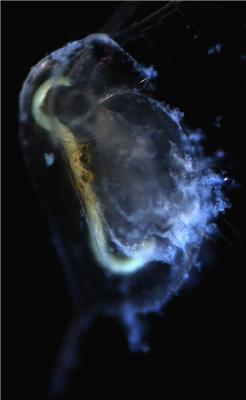Nov 15 2012
New study: Higher sensitivity is found only in the offspring of water fleas, even though only the parents had been exposed to these materials
 Daphnia coating © André Dabrunz
Daphnia coating © André Dabrunz
Nanoparticles are more harmful to small animals than tests have indicated to date. This has been shown in a new study of the University of Koblenz-Landau. Thus, the offspring of water fleas (Daphnia magna) exposed to nanoparticles of titanium dioxide react significantly more sensitively than the offspring of parents from a control group. This is the case even though the offspring themselves are not exposed to the nanoparticles. With the usual test methods, no effects attributable to nanoparticles were found. Until now, standard tests do not investigate the effects in the next generation.
According to the dosage of the nanoparticles, the offspring are two to five times more sensitive to these particles than untreated water fleas. In concentrations 50 times less than the usual effect threshold in parents, titanium dioxide - previously thought to be toxicologically harmless - already showed considerable effects in the following generation. The lowest dosage to which the parents were exposed was only 20 times greater than the concentration predicted within the scope of other scientific studies for surface waters. Comparison with the effect thresholds determined in this new study therefore indicates a risk in the regulatory risk assessment.
The sensitivity of the test animals was determined on the basis of their swimming behaviour as a function of different titanium dioxide concentrations. The impaired swimming behaviour of the offspring possibly restricts their survival capability, and the organisms could also react more sensitively to other stress factors, such as pesticides or metals. By contrast, in the parent generation no effects can be recognised even after longer exposure times. Whether similar and other effects occur with other nanomaterials or organisms is not known at present.
Standard tests not suited
“The study substantiates that nanomaterials, due to their special properties, can induce surprising effects", explains Professor Ralf Schulz of the Landau Department of Environmental Sciences at the University of Koblenz-Landau. "Classical investigations and risk assessments are therefore not sufficient. The regulatory authorities must aim to support the further development and introduction of more suitable tests in order to be able to better assess the long-term risks. Ultimately, nanoparticles are permanently released to the environment."
The toxicity of materials for the aquatic environment is mostly investigated on the basis of standard tests, such as those on water fleas. These organisms play an important role in the food chain of lakes and ponds, are easily bred and react sensitively to harmful substances. Their impact can be quickly and easily determined using the mobility of the water fleas. To this end, there are standardised procedures from the Organisation for Economic Co-operation and Development (OECD) in order to allow the comparison of values. Nevertheless, these are limited to a single generation and do not consider their offspring. "However, these tests do not allow any conclusions in respect of the effects of these materials on humans", adds Dr. Mirco Bundschuh, another of the study's authors.
Numerous industries, such as the electronics, chemical, medical or cosmetic industries, are already utilising nanoparticles on a large scale. For example, sunscreens, deodorants, toothpastes or salad dressings all contain nanoparticles of titanium dioxide as a brightening agent. With sunlight the substance can also purify wastewater and air, as well as producing electricity or hydrogen. The properties depend upon the size and structure of the 1 to 100 nanometer tiny particles, which are therefore around a thousand times thinner than a human hair. On the basis of the growth forecasts for the production and use of nanoparticles, one can expect that they will increasingly be released to the environment. Although little is known about their effects on humans and the environment, products with nanoparticles require no special identification.